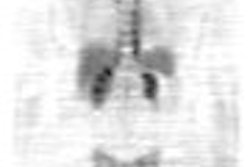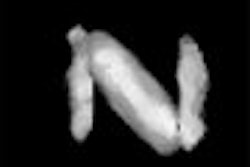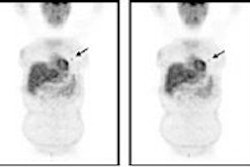Women whose breast cancer is detected by routine screening mammography have better prognoses and outcomes than those whose cancer is found by other means, according to a study in the latest issue of the Journal of the American Medical Association.
Researchers from Helsinki University Central Hospital in Finland confirmed a strength of breast cancer screening: its ability to detect smaller, less-invasive tumors that have biological features more favorable to an array of treatments.
Oncologist Dr. Heikki Joensuu and colleagues retrospectively looked at the records of 1,983 women with unilateral invasive breast carcinoma, compiled by the Finnish Cancer Registry in 1991 or 1992. Finland's female population has a screening compliance rate approaching 90%, the authors said. They also analyzed the histological and biological features of tumors found on mammographic screening.
"For study inclusion, the following information was required for each patient: the date of diagnosis, age at diagnosis, information about other malignancies, postsurgical primary tumor size, axillary nodal status, follow-up data, and the vital status data at the end of follow-up," the authors explained (JAMA, September 1, 2004, Vol. 292:9, pp. 1064-1073).
Of the total study population, 22% (443) of the women were diagnosed with breast cancer based on tumors detected by screening, with the majority, 62.5% or 277, found in women ages 50-59. The most common screening interval was two years and, of the 443 women, 106 had tumors detected during the first screening round. Of the 1,540 women whose cancer was spotted outside of screening (self-detected, those who refused screening), 24.7% (381) were ages 40-49.
Regarding treatment, more women with tumors that were found outside of screening (71% versus 51%) underwent mastectomy and axillary dissection. Thirty-nine percent of those whose tumors were detected with screening had breast-conserving surgery and axillary dissection. Both sets of patients received postoperative breast irradiation.
The tumors were classified into three histological types: ductal carcinoma, lobular carcinoma, and other. Tumor samples underwent microarray analysis and ERBB2 staining for immunohistochemistry. The Kaplan-Meier method was used for statistical analysis.
According to the results, cancerous tumors detected by screening were most common in ages 50-59 and 60-69. Of these lesions, 38% were 10 mm or smaller in diameter versus 14% of tumors found outside screening. In addition, women with cancerous tumors detected by mammography screening -- regardless of age at time of diagnosis -- had better distant disease-free survival.
"The relative hazard ratio (HR) for distance recurrence among women with tumors detected outside of screening (HR, 1.90; 95% confidence interval, 1.15-3.11) was significantly higher than among women with tumors detected by mammography screening," the authors stated. "Breast cancer diagnosis by mammography screening was an independent prognostic variable reducing the relative HR for distant recurrence."
The authors noted that, in some cases, tumors were detected between mammography screening rounds, and these women were included in the outside-of-screening group. These tumors appeared to be more common in premenopausal women and women on hormone replacement therapy. This is most likely due to denser breast parenchyma, although the technical quality of the exams and the skill of the interpreting radiologist may also be factors, they said.
Favorable biological features of smaller tumors detected by screening included better differentiation, lower cell proliferation rate, and fewer axillary lymph node metastases. Also, tumors found with screening were less likely to be associated with breast pain, pressure, or nipple discharge, they said.
The results of this analysis should further research in identifying patients who will most benefit from adjuvant therapies, wrote Dr. Ruth O'Regan, from Atlanta's Winship Cancer Institute, in an accompanying editorial.
"A major strength of this study is that Joensuu et al divided patients into groups based on actual tumor size.... Much research is currently focused on tailoring the use of adjuvant systemic therapies and on identifying patients with tumor characteristics associated with a favorable prognosis.... It is clear that cancerous tumors detected by mammography screening are generally smaller and may have a less aggressive phenotype," she explained (JAMA, September 1, 2004, Vol. 292:9, pp.1062-1063).
By Shalmali Pal
AuntMinnie.com staff writer
August 31, 2004
Related Reading
HRT and low body mass reduce sensitivity of mammography, August 27, 2004
One in five women has false-positive mammogram over 20 years, August 23, 2004
MRI breast cancer test benefits high-risk women, August 29, 2004
Copyright © 2004 AuntMinnie.com



















